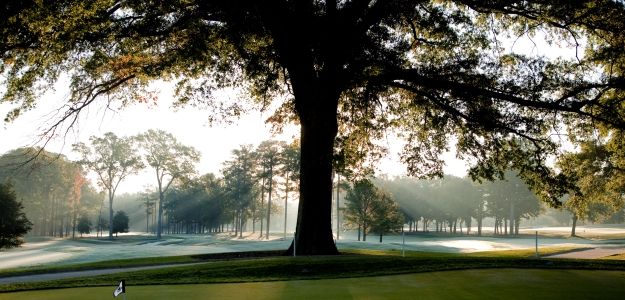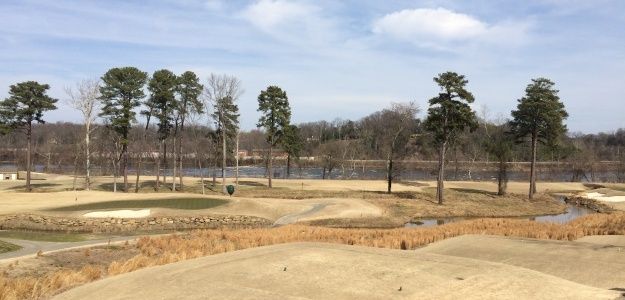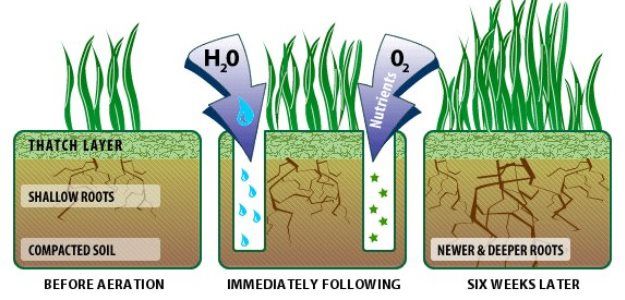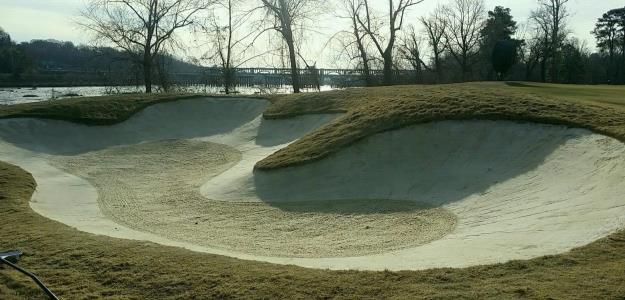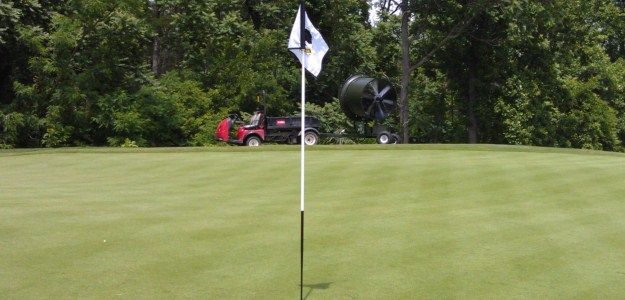|
WHY WERE THE GREENS AERIFIED IN EARLY MAY?
Earlier this month, the team performed deep-tine aeration on the greens. This was completed to improve air and water filtration to the deeper part of the green profile During Spring aerification in March; rain prevented the contractors from performing Drill & Fill. While we were able to perform other aeration processes during that time, a Deep-tine was also performed to help replace the benefits missed from Drill & Fill. Both the Drill & Fill and deep-tine aerations open channels 7-8” deep in the green. These channels provide better water inflation and air movement deep in the green profile, while typical aeration only disturb the top 4” of the profile. This deep-tine aeration will be very beneficial for continued root growth this Spring.
THERE ARE SEVERAL LARGE CIRCLES AND PATCHES ON THE TEES AND FAIRWAYS. WHAT IS THE CAUSE AND WILL THERE BE PERMANENT DAMAGE TO THE TURF?
If you have played over the last couple of weeks, you have noticed the large rings or circles on many fairways and tees. These areas are a Bermudagrass turf disease known as Large Patch. This disease is evident during cool and wet conditions in the spring, and occasionally the fall; and rarely causes damage to Bermudagrass. The rings are more prevalent this year due to early spring transition or “greened up” and the cool, wet, and cloudy conditions. The rings are more visual than destructive on Bermudagrass. We experience this almost every spring, and as in past years, the grass will recover quickly as temperatures increase.
SOME OF THE BERMUDAGRASS COLLARS ON THE COURSE ARE BARE AND THIN. WHEN WILL THESE AREAS RECOVER?
Some collars are bare, while some are thin. The thin areas will recover quickly when temperatures increase. When the collars recover, the turf is healthier and provides a better long-term playing surface. Our team will begin sodding the bare collars next week. We have been waiting until quality sod is available. The cool nights and cloudy days we have experienced have also created challenges for the sod farms. Sodding collars is a difficult process, and quality sod is essential for it to be successful. This process will go throughout the week, beginning with the removal of dead areas on Tuesday. Our team will be sodding during play on Wednesday and Thursday. Areas around the greens where sod has been removed, or sod has been laid will play as “ground under repair”. Thank you in advance as this will require patience on the part of the golfer and our team. A reminder of club rules, Pull carts may not be taken within 5 feet of greens, tees and bunkers.
WHY IS THE TURF THIN AND NOT RECOVERING FROM DIVOTS ON THE BACK TEE ON #2 AND THE BACK TWO TEES ON #11? WHAT IS THE SOLUTION?
The Black/Blue tees on #2 and #11 will also be sodded in the coming weeks. Both of these tees are shaded by trees that cannot be removed and struggle to recover from the amount of divots they receive. Once these tees are sodded, the tee markers on these holes will be moved forward until the sod is ready for traffic.
SOME GOLFERS LIKE FASTER GREENS, WHILE OTHER GOLFERS PREFER A SLOWER SPEED. WHAT HAS THE GREEN COMMITTEE DONE TO ADDRESS THIS TOPIC?
This year the Green Committee has worked with the Director of Agronomy to establish a green speed standard. This standard will ensure a consistent green speed is maintained. Below is the language that was approved by the committee at the May meeting. The benchmark for Willow Oaks greens speed is USGA Stimpmeter speed range from 9 to 11 with a daily greens speed between 10 and 11 in favorable climatic conditions. During periods of intense heat or drought, or other dramatic weather conditions, agronomic practices may be altered to protect the health of the greens. Agronomic practices should result in consistency in greens speed throughout the course and the golf week.
WEEDS ARE BEGINNING TO EMERGE AROUND THE COURSE. WHAT IS BEING DONE TO REMOVE THEM?
You are probably noticing some Poa annua and Nutsedge on the course this spring. The cooler wet conditions we have experienced this spring provide a great environment for these weeds to thrive. Our team has been unable to make the applications needed to kill these weeds due to the cooler temperatures that increase the risk of damage to the Bermudagrass. The Bermudagrass is green; however it is not actively growing due to the cooler nighttime temperatures. The course received frost only 12 days ago, slowing the growth of the Bermudagrass even more. As temperatures increase over the next two weeks, and the risk of damage to the Bermudagrass diminishes, our team will make the needed applications.
WHY ARE THE AREAS FILLED WITH SAND BETWEEN THE FORWARD TEE ON #12 AND THE FAIRWAY?
The holes exist due to a failing drainage line that crosses the hole, leading from #10 approach to the drainage inlet located in the rough on the right of #12. The pipe has started to separate at several connections across #12 rough. We have explored various options for repair, and have determined that the best solution is to excavate and replace the entire pipe from the cart path on the left of #12 to the drainage inlet on the right side of #12. Due to the disruption this project will create, repairs will be scheduled during the fall/winter.
WHY ARE TREES AROUND THE COURSE BEING TRIMMED?
Over the past several weeks, the golf course maintenance team has removed lower limbs from several trees around the course. These limbs were removed to allow more sunlight to reach the turf and improve quality in the area around the tree. Some limb removals were recommendations from our golf course architect, Andrew Green to improve playability of the hole. | 



